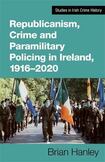
In 1998, Sinn Féin made a submission to the Commission on Policing in Northern Ireland that contained the assertion: “despite decades of hostility towards the RUC [Royal Ulster Constabulary] and a widespread refusal to use it, criminal and antisocial behaviour is significantly less within the nationalist community than in any other society in the world”.
This righteousness was highly disingenuous; alternative “policing” by republicans frequently involved brutality and intimidation. There was nothing new in this, as this brief, well-researched book demonstrates. Hanley has ably amassed a wealth of sources to illustrate the many connections between republicanism and crime, and the parallel claims by armed republican groups of “political perspectives, historical lineage and forms of activism that set them apart from criminal organisations”.
Hanley is not seeking to polemicise the theme; indeed, he goes out of his way to avoid a judgmental tone, sometimes at the expense of frankness. He suggests “crime is an often contested and elusive concept” (it is hardly that elusive), and perhaps too kindly, that many republicans have grappled with the “meaning of crime”, but he certainly highlights how many of them, north and south, conveniently compartmentalised their mixed thoughts. The first in a series of short books under the banner Studies in Irish Crime History, Hanley’s is an original overview and provides important context for the different phases of the relationship between Irish republicanism and crime.
During the War of Independence, with the Royal Irish Constabulary under pressure and a resultant upsurge in crime, the IRA responded by creating the Irish Republican Police who performed tasks as diverse as curbing “the menace of hurling on the roads” and suppression of poitín distillation and poaching. One euphemism used was the need for “a little rough handling”, though flogging divided opinion. IRA units were also divided over the issue of bank robberies but there was always self-interest evident, so much so that “examples of IRA members carrying out robberies for personal benefit are more common than cases where the proceeds reached headquarters”. The constant need for arms procurement meant establishing connections across Europe and North America “with elements it would have avoided in Ireland itself”.
READ MORE
There was an abundance of crime during the Civil War and in its immediate aftermath including audacious armed robberies, authorised by the anti-Treaty IRA from May 1922, some involving viciousness. Even in 1924 there were 142 armed raids in Dublin alone. By the time of the second World War, the IRA leadership was again prepared to authorise bank robberies but these actions marginalised the organisation and it remained chronically underfunded. An IRA officer in Armagh in 1967 was direct about this money dilemma: “we should be prepared to take it where we can get it”. Between 1967 and 1972 an estimated £107,570 was stolen in bank robberies in the Republic.
Dissidents in Saor Éire also adopted this strategy, including the attempted robbery that led to the killing of Garda Richard Fallon in 1970; from 1970-1980, five gardaí and four civilians were killed as a result of robberies by republicans in the Republic. The Provisional IRA (PIRA) heists of that period included the theft of £24,000 in gate receipts from the Munster hurling final in Thurles in July 1977. The proliferation of republican factions, including the INLA, ensured that between 1974-6 there were 81 armed robberies and 56 post office robberies in the Republic. Meanwhile, by the mid-1970s the Official IRA “had become adept at fraud centred around the construction industry”.
Lying publicly and internally about involvement in so-called “special activities” was common, while some of those who engaged in a “homer”, the euphemism for a self-gain robbery, were kneecapped. The catalogue of robberies and criminality helped create a political consensus that “supported the maintenance of draconian legislation”.
Hanley also focuses on the “blurring of boundaries” in more recent decades; republicans carried out an estimated 1,228 punishment shootings between 1973 and 1997 “though almost certainly many more went unreported”. They were often popular with communities affected by antisocial behaviour; self-policing was a resistance strategy but it was also about control and consolidation and much hypocrisy, as the vigilantes engaged in egregious practices they denounced in others. The PIRA also conveniently used the cover name Direct Action Against Drugs from 1995-6 to kill people without formally breaking its ceasefire, while the Northern Bank robbery in December 2004 (£24 million) was perhaps partly a message to proclaim the PIRA was still intact.
More recently there has been the use of “legacy” reputations in the criminal underworld; in 2015, the Criminal Assets Bureau claimed to have confiscated €28 million from more than 50 individuals with previous “connections or associations” with the PIRA, but now involved in criminality. Another measure of the ongoing relevance of Hanley’s theme is that “all of the armed organisations that are still active claim some form of policing role as part of their remit”.
Diarmaid Ferriter is Professor of Modern Irish History at UCD. His most recent book is Between Two Hells: The Irish Civil War (Profile Books)















